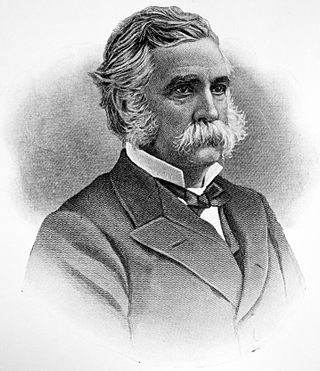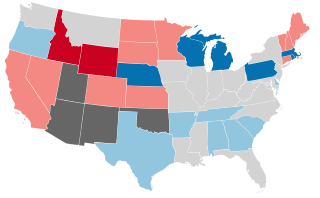
Presidential elections were held in the United States on November 7, 1876. Republican Governor Rutherford B. Hayes of Ohio very narrowly defeated Democrat Governor Samuel J. Tilden of New York. Following President Ulysses S. Grant's decision to retire after his second term, U.S. Representative James G. Blaine emerged as frontrunner for the Republican nomination; however, Blaine was unable to win a majority at the 1876 Republican National Convention, which settled on Hayes as a compromise candidate. The 1876 Democratic National Convention nominated Tilden on the second ballot.

Samuel Jones Tilden was an American politician who served as the 25th governor of New York and was the Democratic nominee in the disputed 1876 United States presidential election.

The 1964 United States Senate elections were held on November 3. The 33 seats of Class 1 were contested in regular elections. Special elections were also held to fill vacancies. They coincided with the election of President Lyndon B. Johnson by an overwhelming majority, to a full term. His Democratic Party picked up a net two seats from the Republicans. As of 2023, this was the last time either party has had a two-thirds majority in the Senate, which allowed the Senate Democrats to override a veto, propose constitutional amendments, or convict and expel certain officials without any votes from Senate Republicans. However, internal divisions would have prevented the Democrats from having done so. The Senate election cycle coincided with Democratic gains in the House in the same year.

John Crepps Wickliffe Beckham was an American attorney and politician who served as the 35th governor of Kentucky and a United States senator from Kentucky. He was the state's first popularly-elected senator after the passage of the Seventeenth Amendment.

The New Hampshire Senate is the upper house of the New Hampshire General Court, alongside the lower New Hampshire House of Representatives. The Senate has been meeting since 1784. The Senate consists of 24 members representing Senate districts based on population. There are 16 Republicans and 8 Democrats currently serving in the Senate.
The Pennsylvania Republican Party (PAGOP) is the affiliate of the Republican Party in the U.S. state of Pennsylvania, headquartered in Harrisburg. The party is led by Lawrence Tabas, who has served as state chairman since 2019. It is the second largest political party in the state behind the Pennsylvania Democratic Party.
Samuel Edwin Merwin, was an American politician who was the 64th Lieutenant Governor of Connecticut from 1889 to 1893.

The 1803 United States Senate election in New York was held on February 1, 1803, by the New York State Legislature to elect a U.S. senator to represent the State of New York in the United States Senate.

The 1819/1820 United States Senate election in New York was held on February 2, 1819, and January 8, 1820, by the New York State Legislature to elect a U.S. Senator to represent the State of New York in the United States Senate.

The 1858–59 United States Senate elections were held on various dates in various states. As these U.S. Senate elections were prior to the ratification of the Seventeenth Amendment in 1913, senators were chosen by state legislatures. Senators were elected over a wide range of time throughout 1858 and 1859, and a seat may have been filled months late or remained vacant due to legislative deadlock. In these elections, terms were up for the senators in Class 2.

The 2018 Guam gubernatorial election took place on November 6, 2018, to elect the next governor of Guam, concurrently with the election of Guam elections to the United States House of Representatives, and various state and local elections.

The 1892 Connecticut gubernatorial election was held on November 8, 1892. It was a rematch of the 1890 Connecticut gubernatorial election. Democratic nominee Luzon B. Morris defeated Republican nominee Samuel E. Merwin with 50.31% of the vote.

The 1888 Connecticut gubernatorial election was held on November 6, 1888. Republican nominee Morgan Bulkeley defeated Democratic nominee Luzon B. Morris with 47.94% of the vote.

The 1886 Connecticut gubernatorial election was held on November 2, 1886. Republican nominee Phineas C. Lounsbury defeated Democratic nominee Edward S. Cleveland with 46.19% of the vote.

The 1889 Rhode Island gubernatorial election was held on April 3, 1889. Democratic nominee John W. Davis received 49.38% of the vote and the Republican nominee Herbert W. Ladd 39.13%. With no candidate attaining a majority of the vote it was decided by the Rhode Island General Assembly. In the same election, the Republican Party had won a small majority in the legislature and selected Ladd as governor.

The 1878 Connecticut gubernatorial election was held on November 5, 1878. Republican nominee Charles B. Andrews defeated Democratic incumbent governor Richard D. Hubbard with 46.66% of the vote.

The 1908 Washington gubernatorial election was held on November 3, 1908. Republican nominee Samuel G. Cosgrove defeated Democratic nominee John Pattison with 62.56% of the vote.

United States gubernatorial elections were held in 1890, in 27 states, concurrent with the House and Senate elections, on November 4, 1890.

The 1833–34 Massachusetts gubernatorial election consisted of a popular election held on November 11, 1833 and a legislative vote held in January 1834. The task of electing the governor fell to the Massachusetts General Court because no candidate received the constitutionally required majority of the popular vote.

A general election was held in the U.S. state of Wyoming on Tuesday, November 7, 1950. All of the state's executive officers—the governor, secretary of state, auditor, treasurer, and superintendent of public instruction—were up for election. The Republican Party swept all of the offices. Following Democratic governor Lester C. Hunt's election to the U.S. Senate in 1948, Republican secretary of state Arthur G. Crane had been acting as governor. Republican Congressman Frank A. Barrett was elected governor, and Republican candidates won the other statewide races.





















